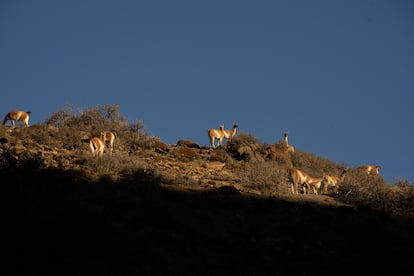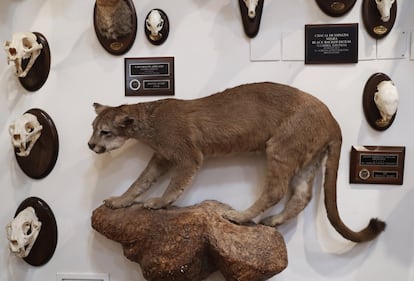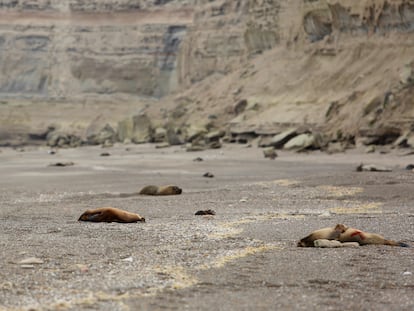Argentine province authorizes the sport hunting of pumas, foxes, and guanacos
Ranchers in Patagonia insist that the measure helps stop attacks by predators and loss of pastures for livestock. Environmentalists are concerned about the loss of biodervisity and damage to ecosystems

The Argentine province of Santa Cruz, in the Patagonia region, has authorized the sport hunting of wild animals at the request of agricultural producers, rekindling criticism from environmentalists who warn that it could lead to a loss of biodiversity. Two photographs, a copy of an identity document, a certificate stating that an applicant has no criminal record and the payment of a fee of $40 allow the hunting of pumas, red foxes and guanacos. The provincial authorities have defended the measure, saying that the activity has been carried out for many years without harm.
The measure was introduced at the end of March by the Santa Cruz Agrarian Council. The hunting season is in force from April 1 to August 31. The decision has revived a historic and unresolved dispute, because livestock producers — especially sheep farmers — insist on allowing sport hunting as a way to stop puma and fox attacks on their flocks and to prevent guanacos from devastating pastures in an area characterized by arid steppe land.
According to Santa Cruz’s Wildlife Law, which dates from 1994, sport hunting is “the lawful art of hunting animals with permitted elements and for non-profit purposes.” For environmentalists, it is a reprehensible activity and they are demanding the application of new strategies, at the same time acknowledging the tourist business that exists around hunting.
Each valid license-holder can hunt up to eight species. The quotas are one red fox, one gray fox and one puma per week, and two guanacos per day. In the case of the European hare, mink, European rabbit, and wild boar there are no restrictions because they are considered “invasive exotic species.”
The president of the Vida Silvestre Foundation, Manuel Jaramillo, warned of the risk of biodiversity loss in Argentine Patagonia and pointed out that allowing hunting is far from providing an answer to the repeated problems of livestock producers. “The solution is coexistence between wildlife and livestock. They prefer to hunt animals even though they do not get an effective response because, year after year, they kill a significant number of pumas and foxes and yet there has been no solution,” the environmentalist told EL PAÍS.
Adrián Suárez, president of the Agrarian Council, justified in an interview with local radio station Tiempo FM that “the activity has been authorized in the province for many years” at this time of the year because the animals “are not in a reproductive stage.” He added he was surprised by the reaction to the resolution. “There are many people who make a living from this productive activity and from hunting tourism,” Suárez argued. Experts say that this time the measure has generated more widespread rejection because there is greater awareness of the need to protect ecosystems and preserve biodiversity.

Lack of data, a key factor in the discussion
When asked by EL PAÍS, the Council’s Director of Fauna Amanda Manero detailed that in 2023 there were 160 registered hunters, and explained that the number “has not increased much in recent years.” “In sport hunting, products are not sold. We allow this type of activity because we know that in the case of pumas and red fox, according to ranchers’ records, the number of individuals is growing,” said the biologist. “The producers know how many sheep they are losing due to predation,” she added, although she acknowledged that “there are no exact numbers for pumas or foxes.”
Jaramillo said that the authorization of hunting is a recurring problem due to the constant complaints from agricultural producers about the guanaco population, which “competes” for the available pasture lands. Livestock farmers also maintain that predators like pumas and foxes compromise the profitability of their businesses. “We ask that decisions be made based on scientific indicators on animal density and not purely on the basis of assessments by landowners, who say that there are many animals,” added the president of Vida Silvestre.
The lack of data is a central issue in the discussion. With the controversial measure in force, the provincial deputy Carlos Godoy demanded the provincial Agrarian Council provide information about the criteria used — such as technical data and census of individuals — although so far the state organism has not replied to the request, leading the legislator to demand that the resolution authorizing hunting be suspended.

Trained dogs and technology, alternatives to hunting
For Jaramillo, dogs to protect livestock could play a key role in deterring potential predators. “Predation by pumas is reduced to almost zero,” he said, citing a study conducted by the NGO itself years ago, although this would imply a transcendental change in the productive culture. “Many people are not willing to adopt these methods,” he noted, highlighting the role of technologies such as halogen lights and ultrasound, although he clarified that they are valid alternatives in confinement contexts if not for use in the open field.
So far, the projects tabled in the Santa Cruz provincial legislature to stop sport hunting have failed. “Not only is it aberrant that killing a native species is considered a sport, but also the vested interests of the ranchers, because [predators] kill the cattle or the guanacos eat the grass for their the sheep and cows,” said Godoy, who proposed alternatives such as the incorporation of mules or donkeys, as well as flashing lights to scare away the pumas or trained dogs. “With respect to the guanacos, if overpopulation is proven, it would not be the first time that specimens have been moved to other provinces,” he noted.
“Livestock ranchers are working on alternatives because after 150 years of uninterrupted hunting they have realized that losses due to predation are not decreasing,” said Manero, who mentioned the relevance of herding dogs and indicated that many farmers have begun to use them.
Jaramillo said that situations like those in Santa Cruz are replicated in other provinces, not only through the authorization of hunting but also with the application of poisoned baits and traps, used to kill animals that are considered “pests” by the ranchers, “with a lack of integral vision of the role that these species play in maintaining the productive capacity of the soil, the health of the ecosystem, and in the control of pathogens and disease vectors.”
Although the environmentalist clarified that he does not advocate the death of any animal, he did recognize the need to control invasive species that have become an “environmental problem,” as is the case with the red deer or wild boar in different parts of the country. “They were introduced to produce a hunting industry and are invasive. They colonize the environments of native species and these populations must be significantly reduced because they compromise the development and survival of native animals,” he argued.
The lack of data prevents us from knowing precisely what impact hunting has had on species such as the puma or the red fox — which are not currently endangered — and to what extent hunting could cause serious damage to the conservation of the species. Jaramillo emphasizes that, in the case of pumas, they are territorial animals and according to research fewer than 20% consume animals such as sheep and foals. “They are apex predators, they control meso-predators (such as foxes). If there is an increase in foxes, there may be a higher frequency of attacks on ewes and newborn lambs,” he points out.
For his part, Godoy reflects that the world is going through a paradigm shift and calls for progress towards animal conservation. “For many, the alternative cannot be killing for sport. While waiting for a response from the provincial government native species continue to be killed,” he says.
Sign up for our weekly newsletter to get more English-language news coverage from EL PAÍS USA Edition
Tu suscripción se está usando en otro dispositivo
¿Quieres añadir otro usuario a tu suscripción?
Si continúas leyendo en este dispositivo, no se podrá leer en el otro.
FlechaTu suscripción se está usando en otro dispositivo y solo puedes acceder a EL PAÍS desde un dispositivo a la vez.
Si quieres compartir tu cuenta, cambia tu suscripción a la modalidad Premium, así podrás añadir otro usuario. Cada uno accederá con su propia cuenta de email, lo que os permitirá personalizar vuestra experiencia en EL PAÍS.
¿Tienes una suscripción de empresa? Accede aquí para contratar más cuentas.
En el caso de no saber quién está usando tu cuenta, te recomendamos cambiar tu contraseña aquí.
Si decides continuar compartiendo tu cuenta, este mensaje se mostrará en tu dispositivo y en el de la otra persona que está usando tu cuenta de forma indefinida, afectando a tu experiencia de lectura. Puedes consultar aquí los términos y condiciones de la suscripción digital.
More information
Archived In
Últimas noticias
Delta Force, the elite US military unit that captured Maduro
Maduro to be tried in the US for narcoterrorism and corruption
Maps of the US attack on Venezuela: Targets, airspace and deployed fleet
Venezuelans in exile: ‘This could be the end of a very dark chapter for Venezuela, but also the beginning of a time of uncertainty’
Most viewed
- Alain Aspect, Nobel laureate in physics: ‘Einstein was so smart that he would have had to recognize quantum entanglement’
- David King, chemist: ‘There are scientists studying how to cool the planet; nobody should stop these experiments from happening’
- Mexico completes its trade shift with the entry into force of tariffs on China and countries without trade agreements
- Reinhard Genzel, Nobel laureate in physics: ‘One-minute videos will never give you the truth’
- Oona Chaplin: ‘I told James Cameron that I was living in a treehouse and starting a permaculture project with a friend’










































